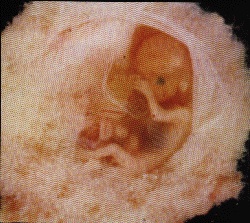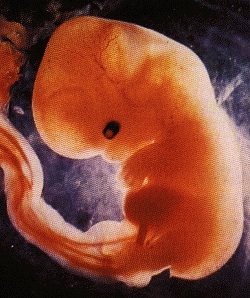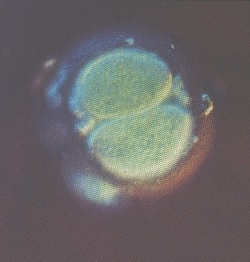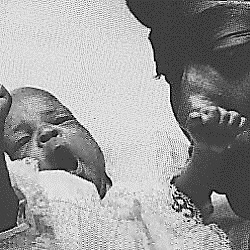 19 weeks: SURVIVED!
19 weeks: SURVIVED!
This is Kenya King, born at 19 weeks, or just a little more then 4 1/2 months after her life began. Pictured here with her mother, Lisa King, Kenya weighed only 18 ounces when she was born in Florida on June 16, 1985. When this photo was taken, Kenya weighed 5 pounds.[1]Babies can routinely be saved at 21 to 22 weeks after fertilization, and sometimes, like Kenya, they can be saved even younger.[2][/one_half_last]
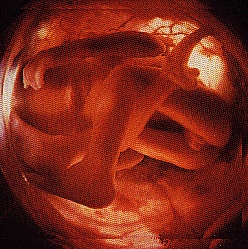 18 weeks: “VIABLE” TOMORROW?
18 weeks: “VIABLE” TOMORROW?
This is an unborn baby only 18 weeks old, just before viability. Viability is the time when the baby is able to survive outside the mother. Not long ago viability was at 30 weeks; then it was 25 weeks.
Now viability is even earlier. What will it be tomorrow? Science is constantly making progress in this area.[3][/one_half_last]

 18 weeks: PERFECTLY FORMED
18 weeks: PERFECTLY FORMED
This beautiful unborn baby is 18 weeks old, just one week younger then Kenya was when she was born.
Inside the mother, this baby could have been legally killed. However, outside of the mother the baby would be fully protected by law.[/one_half_last]
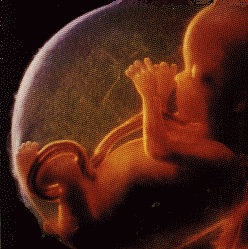 14 weeks: A MIRACLE OF DEVELOPMENT
14 weeks: A MIRACLE OF DEVELOPMENT
The baby in this picture is less than 14 weeks old. At this age, the heart pumps several quarts of blood through the body every day. A twelve-week-old unborn baby has developed the body parts required to experience pain, including all of the nerves, spinal cord and thalamus.[4]
The inserted picture shows details of the legs of a baby about 16 weeks old.
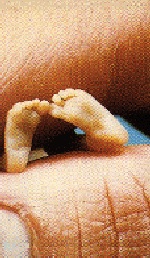
11 weeks: ALL ORGAN SYSTEMS FUNCTIONING
10 – 11 weeks: SENSITIVE TO TOUCH
This baby is 10-11 weeks old. The baby can “breathe” amniotic fluid and urinate.[7]
At this age she or he will seize an object placed in the hand.[8]
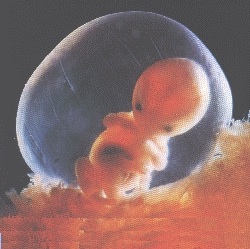
7 weeks: ALREADY KICKING
A 7-week-old unborn baby swims freely in the amniotic sac with a natural swimmer’s stroke.[11]
Even though the baby is moving around in the uterus, the mother does not begin to feel the baby until about 4 1/2 months into pregnancy.[12]
6 weeks: BRAIN WAVES
This is a baby just six weeks old. Three weeks earlier, the baby’s heart had begun to beat and pump blood. The baby’s blood type is often different from the mother’s blood type.[13]
A microscope would reveal that this little baby has the characteristic
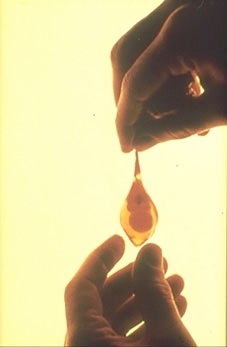
46 human chromosomes in every cell, demonstrating clearly that this is a human being.[14]
At six weeks, the baby has brain waves that can be measured with an electroencephalogram. The end of human life can be defined as the cessation of brain waves, but many ignore the scientific evidence of brain waves in unborn babies.[15]
However, the real beginning of human life is earlier still.
Fertilization: LIFE BEGINS!
Life truly begins at fertilization. At fertilization, when the sperm and the ovum meet to form a single cell, a new human life is created.[16]
All characteristics of each person – sex, eye color, shoe size, intelligence, etc. – are determined at fertilization by the baby’s genetic code in the 46 human chromosomes. [17]
Every person begins as a separate single cell; nothing new is added but oxygen and nutrition. If the process is not interrupted, a human being will live about nine months in the mother’s uterus and decades outside it. That person has never existed before and will never exist again. [18]
This photograph was taken about 30 hours after fertilization. Within one week of fertilization, a new human being implants in the mother’s uterus and is nourished there. [19]
References
[1] Mona Z. Browne, “19-week early preemie wins life struggle,” Miami Herald, October 4, 1985, P. 1A
[2] Gina Kolata “Survival of the Fetus: A Barrier is Reached.” New York Times (March 18, 1989), P. C1
[3] F. Gray Cuinningham, M.D., Paul C. MacDonald, M.D. and Norman F. Grant, M.D., Williams Obstretics, 18th edition, (Norwalk, CT: Appelton and Lang, 1989), P.501. Kolata “Survival of the Fetus: A Barrier is Reached,” New York Times, pp.C1, C5
[4] Landrum B. Shettles, M.D., Ph.D. with David Rorvik, Rites of Life, (Grand Rapids, MI: Zondervan Publishing House, 1983), p.62. Daniel N. Robinson, Ph.D., testimony, hearing on fetal pain, U.S. Congress, Senate Judiciary Subcommittee on the Constitution, May 21, 1985. “Why Pain Hurts: Unlockin An Agonizing Mystery,” TIME, vol. 123 no.24(June 11, 1984), p.61. Arthur C. Guyton, M.D., Textbook on Medical Physiology, 6th ed. (Philadelphia: W.B. Saunders Co., 1981), p.615.
[5] Keith L. Moore, Ph.D., and T.V.N. Persaud, M.D., Ph.D.,D.Sc., The Developing Human, 5th edition, (Philadelphia: W.B. Saunders Company, 1993), pp.428 and 447. Geraldine Lux Flanagan, The First Nine Months of Life, 2nd ed. (New York: Simon and Schuster, 1962),p.48.
[6] Cunningham, MacDonald and Grant, Williams Obstetrics, 18th edition, pp.90 and 103. Robert Rugh, Ph.D. and Landrum B. Shettles Ph.D., M.D., From Conception to Birth; the drama of life’s beginnings(New York: Harper and Row, 1971), pp.52, 53, and 58.
[7]Cunningham, MacDonald and Grant, Williams Obstetrics, 18th edition, P.116, 103-104, 502. Moore and Persaud, The Developing Human, 5th edition, p. 95.
[8] Shettles and Rorvik, Rites of Life, P. 55. H.B. Valman and J.F. Pearson, “What the Fetus Feels,” British Medical Journal (January 26, 1980), p. 234.
[9] Cunningham, MacDonald and Grant, Williams Obstetrics, 18th edition, p. 103
[10] Albert W. Liley, M.D., statement, U.S. Congress, Senate, Subcommitte on Constitutional Amendments of the Committe on the Judiciary, Ninety-Third Congress, Second Session, “Abortion Part 2,” on S.J. Res. 119, and S.J. REs. 130, p. 224.
[11] Valman and Pearson, “What the Fetus Feels,” British Medical Journal, P. 234.
[12] Moore and Persaud, The Developing Human, 5th edtition, pp. 95-96, 304.
[13] Moore and Persaud, The Developing Human, P. 310. Lenart Nilsson and Lars Hamberger, A Child Is Born (New York, NY: Delacorte Press/Seymore Lawrence), p. 86. Rugh and Shettles, From Conception to Birth p. 217.
[14] Dr. Jerome Lejeune, testimony, U.S. Congress, Senate Committee on the Judiciary, “The Human Life Bill,” S. 158, Ninety-Seventh Congress, First Session, 1983, Vol. 1, pp. 8-10.
[15] Hannibal Hamlin, M.D., “Life or Death by EEG,” Journal of American Medical Association (October 12, 1964), p 113.
[16] “The Drama of Fetal Development,” American Baby (January 1989), p.45.
[17] Jerome Lejeune, M.D., “The Human Life Bill,” op. cit., volume 1, p. 8.
[18] Ibid.
[19] Nilsson and Hamberger, A Child Is Born, p. 64.

